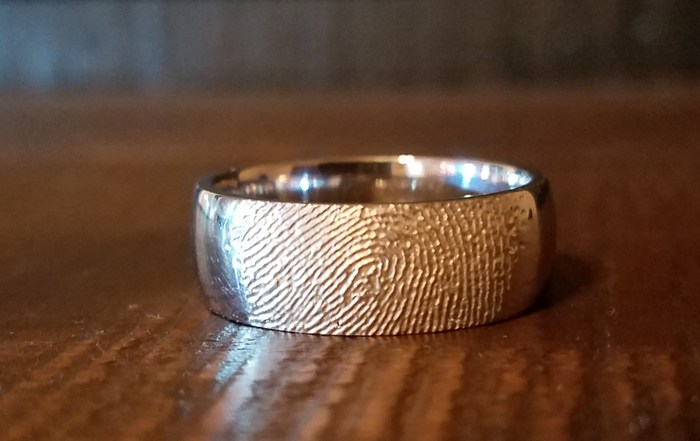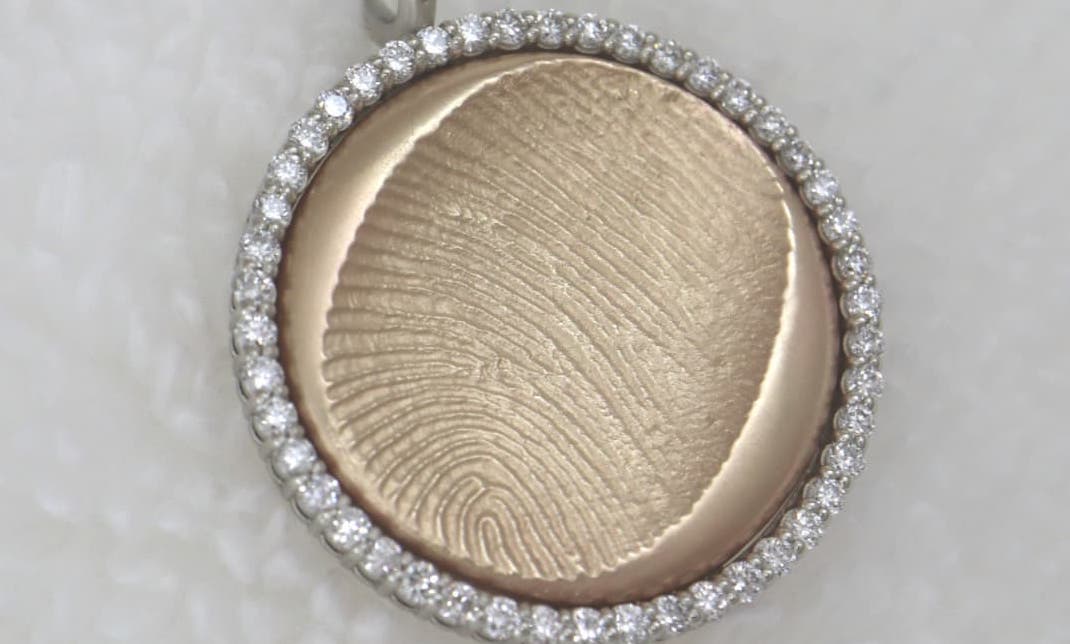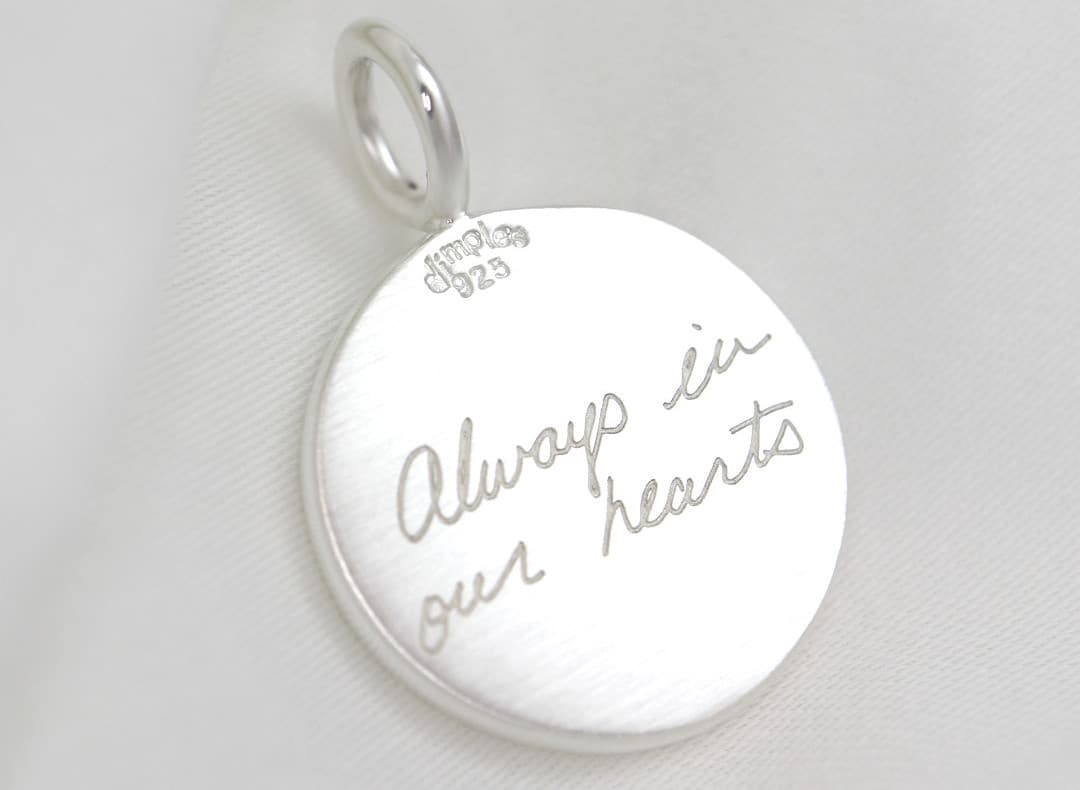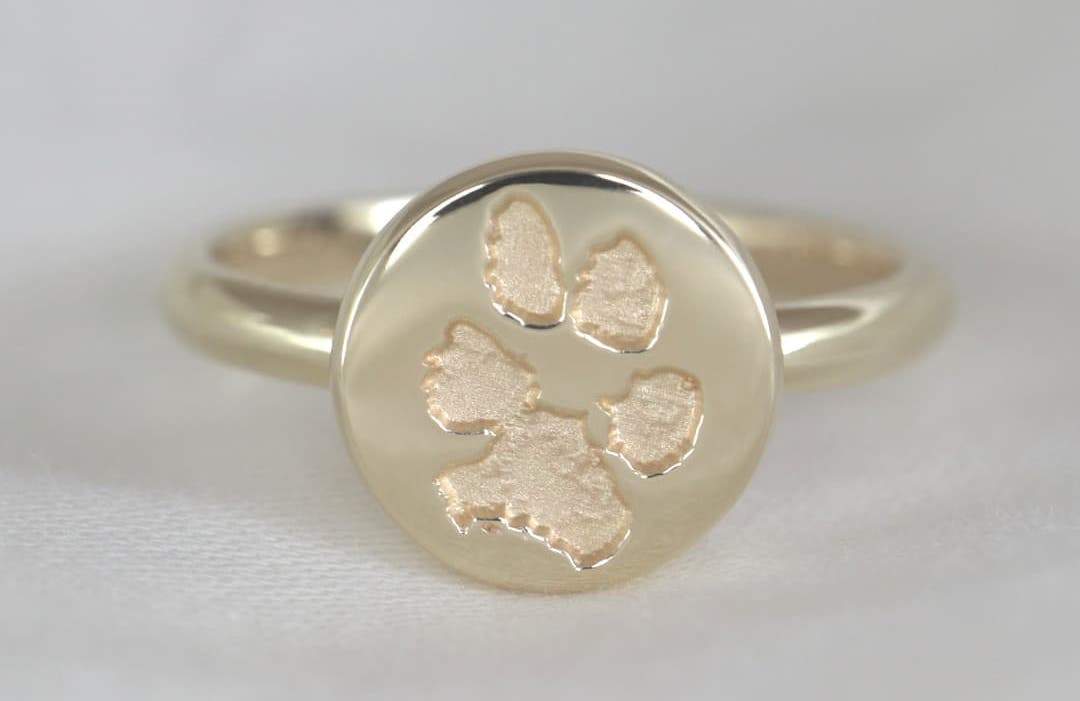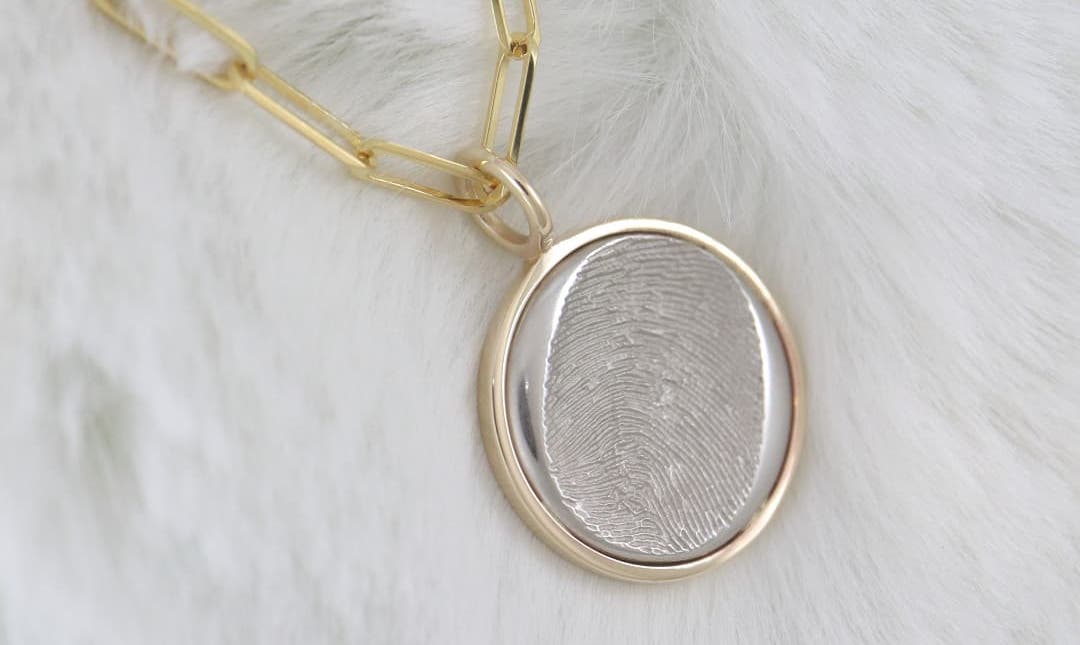Fingerprints are remarkably unique. No two people in history have ever shared the same fingerprints. Even identical twins don’t share the same fingerprints! Almost any time we touch something we leave a trace of our identity on it with a fingerprint. A loving reminder that we were once there.
This “personal touch” is a large part of what motivates people to buy fingerprint jewelry. Whether their jewelry features the fingerprint of a loved one still living, or one they have lost, it becomes a talisman that ties them to that person wherever they are. A substantial amount of psychology research exists that illustrates the tremendous power of linking objects to keep us connected to a time, a moment, or a person that is significant to us. Fingerprint jewelry is one such linking object.
Fingerprint jewelry is often described by its owners as “the most precious thing I own. I never take it off”. Although it is not a new idea, it has been around for ages, it is enjoying a substantial increase in popularity at the moment. It was originally made by impressing a piece of mailable wax with a fingerprint then casting that wax, using the lost wax casting method, into metal. Although this generated nice fingerprint impressions the jewelry was often inconsistent and misshapen, heavy, and unpleasant looking. Modern technologies have made it possible to produce consistent and uniform shapes, lighter pieces, and far more aesthetically pleasing designs. Fingerprint jewelry is the perfect combination of style and sentiment.
Did you know there are actually two different types of fingerprint jewelry? The first, and most sought after, is 3D fingerprint jewelry. 3D fingerprint jewelry looks more luxurious and authentic because it has depth and appears as if your loved one has actually pressed their finger right into the metal. It is sought after because of its appearance. It is lifelike, realistic and is a great reminder of your loved one since it actually looks like they left their mark on it. It also has a much more endearing feel when you run your finger over it and reflect upon the love and memories you share.

The second type is 2D fingerprint jewelry. As you might guess from the name, 2D fingerprint jewelry, it looks flat because it only has 2 dimensions. It lacks the depth that makes 3D fingerprint jewelry so personal and authentic. However, it has merit and will appeal to some, particularly the budget conscious. There are many ways to create fingerprint jewelry and each has its pros and cons. Some are made to be budget friendly and are inexpensive and some are made to look exquisite and last. All are meant to be sentimental and of great significance to you or the person you are giving it to. You get to choose which is right for you.
Before you buy a piece of fingerprint jewelry; however, it is critical that you learn and understand the following 2 things about how it’s made so that you can make the most informed decision and the choice that is right for you. After all, if you are going to invest in a piece of fingerprint jewelry, knowing that it is such an emotionally significant purchase, you should understand what you are buying, right?
Now, the 2 most important things to know about how fingerprint jewelry is made are the materials and the method.
Material
Basically there are 4 materials most commonly used for making fingerprint jewelry. They are: plated, vermeil, sterling silver, and real gold (actual gold).
Plated: Gold plating uses a process known as electroplating to bond a thin layer of gold onto a base metal. This process is typically used for costume jewelry or to mimic more expensive pieces.
As you might guess from the name, electroplating uses an electrical current to bond gold atoms onto the base metal.

The base metals are typically low value materials like brass or copper. By electroplating, layers of gold atoms are built up on the base metal until the thickness is such that the base metal itself is no longer visible and now appears to be gold. As you know, looks can be deceiving. We are talking about atoms here. The total thickness of the plating is measured in microns. If you don’t know, a micron is one thousandth of a centimeter (0.0001cm) so it’s super thin. As you can imagine, this thin layer can quite easily be worn off. Depending on the thickness and the frequency of wear (daily vs. special occasions) this could mean noticeable wear within months of your purchase!
Pros: Best suited for fashion jewelry and infrequent wear. Looks like real gold jewelry. Very low cost.

Cons: Gold plated is NOT real gold. Gold plated jewelry is cheap, but it comes at a cost. The cost? Durability. If you buy plated jewelry you will find yourself having to replace the piece often or having to take it to a jeweler to have it re-plated. Many jewelry stores will charge between $60 and $120 for replating, each time. This will add up if you are doing it once or twice a year! Best suited for jewelry you wear just for fun and have little sentimental attachment to. If, attracted by the very low cost, you buy fingerprint jewelry made using plated material you may find yourself heartbroken when the plating wears off.
Vermeil: Vermeil which is also known as “silver gilt” is basically the same as gold plated because it uses electroplating to bond a layer of gold onto a base metal. The difference is that the base metal is sterling silver which is actually a precious metal. Vermeil is just a fancy name for gold plated silver. In order to be considered true vermeil though, the piece has to meet certain standards. For example, the gold on the piece needs to be at least 2.5 microns thick, and be at least 10k or higher. Just like plated jewelry, vermeil is NOT real gold.

Basically, vermeil is a fancy name for gold plated silver.
Pros: Ideal for fashion jewelry that is worn regularly, but not daily. Better than plated for slightly more frequent wear. Looks like real gold. Although it is more expensive than plated it is a more budget friendly alternative to real gold.
Cons: It is a little better than gold plating but, just like gold plated jewelry the gold can also wear off. It is typically more costly, because of the silver base, which makes it even more disappointing when the plating wears off. The costs for a jeweler to re-plate can be even higher because you will want the minimum 2.5 micron layer to be restored. It is a tiny step closer to fine jewelry, real gold, than plated jewelry. Vermeil is still a fashion jewelry material and is best suited to trendy fashion items that you want to enjoy more often, or as long as the trend lasts, and you won’t be devastated when the plating wears off. Not a good choice for your meaningful jewelry.
Sterling Silver: Pure silver is too soft and malleable for use in jewelry so it is alloyed with other metals to give it more favorable working properties. Sterling silver, also known as 925, is actually an alloy of pure silver composed of 92.5% pure silver and 7.5% alloy, usually copper. Sterling silver is regarded as a precious metal. Although its earliest uses were primarily in flatware, tableware, and currency/coins, it became popular for use in jewelry because of its lustrous white color, durability, and lower cost relative to gold. It is only available in the white color and it can tarnish over time as sulfur in the environment reacts with the copper alloy. Because of its higher value, and favorable durability, sterling silver can be depended on to last for use in fingerprint jewelry. However, it is not as resistant to scratching and wear as gold. It is better suited for use in necklaces, pendants and earrings that will not be as exposed to the heavy abuse that a ring would. Although it is a suitable choice for rings, if it is a ring you are after, sterling silver may not be the ideal choice for someone looking to create a legacy piece that endures for a lifetime(s).
Pros: Lower cost than gold. Good durability. Beautiful white color. It is durable enough for use in fingerprint jewelry. At dimplescharms.com we can craft your jewelry in sustainably sourced sterling silver.
Cons: Not as durable as gold. Only available in the white color.
Real gold: Gold is regarded as a precious metal. Real gold jewelry is made using a solid gold alloy, having gold content above a certain threshold. In the United States, for example, pieces containing less than 41.67% gold (10 karats) are not considered real gold for commercial purposes. This means that any jewelry marked less than 10K (9K for example) is NOT considered gold. Pure gold (24K) on its own is too soft and malleable for use in jewelry so it is mixed with alloy materials like copper, silver, nickel, and paladium. These alloys are added to increase the hardness, decrease the malleability, or change the color of pure gold. Jewelry made using real gold is considered fine jewelry. When gold jewelry is marked 10K it means that 10 out of 24 parts (41.67%) of it are gold and the balance is the alloy material(s). If it is marked 14K then 14 out of 24 parts (58.33%) of it are gold while 18K would be 18 out of 24 parts (75%) gold. Although it is more coslty than plated, vermeil, or sterling silver, since real gold jewelry is made entirely of precious metal (which has value) and is solid all the way through, it is superior in every way. It can be worn daily and passed down through generations. Real gold is the ideal material for jewelry with great sentimental value and that you expect to wear daily. Real gold is definitely the best choice for jewelry that you “never take it off”.
Pros: Used to craft fine jewelry for centuries and trusted for its durability, wearability, and value. The color will never wear off or peel. The most durable, long lasting, and timeless material used in fine jewelry. It has value and its value increases over time. It is solid gold all the way through, is infinitely more durable than plated or vermeil jewelry. It is the ideal choice for jewelry, like fingerprint jewelry, that is of sentimental significance and for jewelry that you wear daily. It’s the perfect choice for jewelry you plan to pass down to successive generations. At dimplescharms.com we can craft your jewelry in sustainably sourced gold in 10K, 14K, and 18K white, yellow, and rose gold. Although it is not covered in this article we can also create fingerprint jewelry in platinum.
Cons: Although it is more valuable and the best choice for fingerprint jewelry it typically means you will pay more for it.
Method
Fingerprint jewelry is not all created equally. It can be made in a variety of different ways. Some of these methods produce 3D fingerprint jewelry and others are limited to 2D fingerprint jewelry. Each of the methods used to create fingerprint jewelry has its pros and cons. There are five common methods used to make fingerprint jewelry. They are: Lost-wax cast, Metal clay, Hand engraving, Laser, and CNC.
Lost-Wax Cast: This is a method used to make 3D fingerprint jewelry. Lost-wax casting is a technique that has been trusted and used to make jewelry for centuries. This method involves making a mold out of a model and pouring molten metal into the mold to create the final part. Although it is a more traditional technique the methods used to create the models have advanced tremendously with the advent of modern 3D technologies like 3D printing. Fingerprint jewelry made using the lost wax casting method is solid, so you know you are actually getting value for your dollar. You also never have to worry about plating or coating wearing off. Furthermore, it has greater density, is more durable, is far more resistant to wear and damage than other methods, and has been trusted for centuries to create jewelry that endures. Jewelry companies that produce fingerprint jewelry this way usually only require a clear and in-focus image of a fingerprint supplied by customers. Fingerprints are stored encrypted offline so they are secure. Fingerprint jewelry made using this method is more personal because it is 3-dimensional. It looks like there is an actual “impression” where the finger was pressed into the metal with the fingerprint lining the surface of the impression. The result is a very authentic, lifelike appearance. It looks as though a finger was pressed into it. Originally, that is how lost wax casting of fingerprint jewelry was made, by pressing a finger into wax. However, advanced technologies now make it possible to create jewelry this way using only an image of a fingerprint, while still maintaining the appearance of the actual touch in the jewelry. This way you are not inconvenienced by having to do a fingerprint a certain way, like having to press a finger into a mold, use a certain scanner, or having to visit an inconvenient location. The image can be any format and sent from anywhere on earth. All that is needed is a clear, in-focus, image of the fingerprint. Companies may manually edit the fingerprint image slightly to resolve all the details but it will remain the same, natural looking fingerprint in the finished piece of jewelry. Since it all starts with an image a replacement piece can be ordered if the original is lost, damaged, or stolen. Other items can also be ordered at any time using the same fingerprint image. Companies that produce this type of jewelry are designers and manufacturers, so your entire piece will be made domestically. These companies prioritize quality and beauty and will not cut corners when it comes to your happiness. If you are wondering how to create a great fingerprint, check out this video that illustrates the simplest method that only requires a pencil, clear tape, and plain white paper.
Pros: This method produces 3D fingerprint jewelry. It looks like an impression was made in the metal and feels like your loved one actually left their mark on it. Lost wax casting is the gold standard for creating the highest quality, most realistic, and most personal fingerprint jewelry. The solid gold fingerprint jewelry made this way will never peel or have its color wear off. It will endure and can be passed down through generations. All that is required is a clear, in-focus, image of the fingerprint. You have the security and peace of mind that a replacement can be made if the original is lost, damaged or stolen. Other items can be ordered any time using the same fingerprint. Fingerprints look very natural. DimplesCharms.com the lost wax casting method exclusively to craft its ultra high definition true to life 3D fingerprint jewelry.
Cons: Prices are higher.
Metal clay: This is a method used to make 3D fingerprint jewelry. Metal clay is a craft material that is commonly used to make jewelry by crafters who sell on etsy. Metal clay is composed of microscopic particles of metal, an organic binder (a type of cellulose), and water. Once shaped into the finished pattern it is dried, to remove the water, then baked (fired) in a kiln to remove the organic binder and fuse the metal particles together during a process called sintering.

It is well suited to making fun “artsy” jewelry as it requires no special skill or training and can be easily shaped, formed, and filed into unique designs when it is soft or before it is “fired”. When it works well, fingerprint jewelry made using metal clay looks interesting because it is 3-dimensional. There is an actual “impression” where the finger was pressed into the clay and the fingerprint was transferred into the surface of the impression. The result is a very lifelike appearance because it’s made by pressing a finger into the material. The trouble is that you have to travel to visit the studio of the craftsperson who makes it or the material needs to be shipped to you, which can be an inconvenience particularly if you are trying to get the fingerprint impression of a baby, a senior, or a loved one in fragile health. It can also be an unpleasant experience because pressing a finger into the clay can require substantial force which can be uncomfortable or even painful. If you have lost a loved one and only have an image of a fingerprint you’ll have to rule this material option out.
It is also only available in fine silver (pure silver) because the gold metal clay is prohibitively expensive. You should also be aware that metal clay, even after firing, is significantly less dense than sterling silver or gold, so pieces made using metal clay are extremely sensitive to daily wear and tear. Details like fingerprints will wear off in a disappointingly short time.
Pros: Fingerprint jewelry made using metal clay looks very lifelike and fingerprints look very natural. Prices are usually lower.
Cons: Fingerprint jewelry made using metal clay is extremely sensitive to wear and tear. Although it can be inexpensive the prices, quality, and appearance vary widely and are unpredictable. It can also be a hassle to visit a studio for the impression and the process of impressing the clay with a finger can be uncomfortable or painful. There is never a duplicate so if the piece is lost, damaged, or stolen it is gone for good. Other items cannot be made using the same print.
Hand engraved: This is a form of 2D fingerprint jewelry. Fingerprint jewelry made this way uses tools called gravers (think, small chisels that have a variety of different shaped ends) a craftsperson traces each line of a fingerprint and carves it into the metal.

. As you can imagine this is a very laborious process. That labor comes at a cost. To keep the jewelry modestly priced, less valuable materials are used to make the jewelry itself. This type of fingerprint jewelry is most often made using sterling silver or 9K gold. They are solid materials so you never have to worry about plating or coatings wearing off. As you learned however, 9K gold is not actually considered gold in the US because it is only 37.5% gold. Because it is easiest to trace the fingerprint lines on a flat surface the jewelry is very flat and 2-dimensional. Fingerprint jewelry made using this method has a very impersonal, sterile appearance and lacks the personality and lifelike touch achieved by a 3D method.

Companies that produce fingerprint jewelry this way will usually send you a fingerprint kit. You do the fingerprint yourself and send it back to them in the supplied self addressed envelope.
Pros: Materials are solid all the way through so you don’t have to worry about plating or coating wearing off. However, some companies will use this method on vermeil so be aware and ask questions to make sure you know what you are buying.
Cons: Fingerprint jewelry made by hand engraving is often made using lower quality materials. Fingerprints look unnatural. The flat lifeless appearance lacks the personal touch that is at the heart of the reason why people want to have fingerprint jewelry, but some people prefer this look. Beauty is in the eye of the beholder. Always check the Google reviews of the company you are considering dealing with.
Laser: This is a form of 2D fingerprint jewelry. It is also known as fingerprint engraved jewelry. This method uses a powerful laser to burn an image of a fingerpint into the surface of a piece of jewelry. Fingerprint jewelry engraved using a laser has a more impersonal, sterile appearance because it is only 2D. Most manufacturers of laser engraved fingerprint jewelry use computerized image editing software that edits fingerprint images quickly, but leaves them looking far less realistic. Fingerprints are typically engraved on flat surfaces and end up being slightly rough to the touch. If budget and speed are your main concerns and you are not fussy about the appearance then this method might be a good choice. These manufacturers will also purchase large quantities of jewelry manufactured quickly, and at very low cost, domestically or overseas to engrave on. Although it may be engraved domestically, the jewelry itself may not actually be made in North America. If done on plated or vermeil the laser can also penetrate through to the base metals leaving them susceptible to tarnish over time. Many of these companies operate through funeral homes. They often have some sort of digital scanner or proprietary way of capturing the fingerprint. Once they have the print they will force you to buy their products. If you would prefer another brand they will charge you for the fingerprint before they release it to you (or the funeral home), which seems wrong. The fingerprint belongs to your loved one and you shouldn’t need to purchase it.

Pros: Fingerprint engraved jewelry made using a laser is very inexpensive to make, but prices for the jewelry varies widely. It can be made very quickly..
Cons: Flat and 2-dimensional in appearance. It can be made very quickly, but the flat, lifeless appearance lacks the personal touch that is at the heart of why people want to possess fingerprint jewelry. Automated fingerprint image editing gives the finished product a computerized and unnatural look.
CNC: This is a form of 2D, flat fingerprint jewelry. The outcome is very similar to laser engraving. CNC is an acronym for Computer Numerical Control. Fingerprint jewelry made using CNC is another form of fingerprint engraved jewelry. Unlike laser engraving, however, CNC uses a rapidly spinning steel bit (picture a pointed drill bit) to carve out a path under the control of a computer to mechanically “cut” the fingerprint into the metal.
Just like the laser engraved version, manufacturers using CNC also employ image editing software that gives fingerprints an unatural appearance. These manufacturers will also purchase large quantities of jewelry that is manufactured quickly, and at very low cost, domestically or overseas to engrave on. Although it may be engraved domestically, the jewelry may not actually be made in North America.

They are engravers of finished jewelry, not the manufacturers of the jewelry. Just like laser engraving though the result is 2D. Although it can appear slightly more realistic than when done with a laser, it still lacks authenticity and looks computerized. Like laser engraved fingerprint jewelry, most companies doing CNC fingerprints operate through funeral homes. They too have some sort of digital scanner or proprietary way of capturing the fingerprint. They will also be possessive about your loved ones fingerprint image and try to coerce you to buy their products. If you would prefer another brand they will then charge you for the fingerprint, which seems wrong because it is your loved one’s fingerprint. If budget is your main concern and you are not fussy about the appearance then this method might be a good choice.
Pros: Fingerprint engraved jewelry made using a CNC appears a little more realistic than when done with a laser. Very inexpensive to make, but jewelry prices vary.
Cons: Usually more costly than the laser engraved version. Typically flat and 2-dimensional in appearance. Can be made very quickly, but its flat lifeless appearance lacks the personal touch that is at the heart of why people want to possess fingerprint jewelry. Automated fingerprint image editing gives the finished product a computerized and unnatural look.
Before you purchase fingerprint jewelry ask yourself the following questions:
- How often do I want to wear this jewelry?
- Where (on my body) will I wear this jewelry? (necklace, ring, earrings, bracelet, etc)
- How long do I expect it to last? Is this just to enjoy for now or do I want it to last forever and possibly hand it down to loved ones at some point?
- What do I want it to look like?
- How much do I want to spend?
Your answers to these questions will help you determine the material and method that are best for you.
If you have any questions about Fingerprint Jewelry, we at Dimples would be delighted to assist you. Reach out anytime at info@dimplescharms.com or 1-844-852-5802.
For the best quality Fingerprint Jewelry and an exceptional experience choose Dimples.



